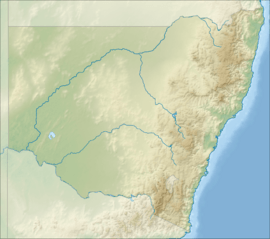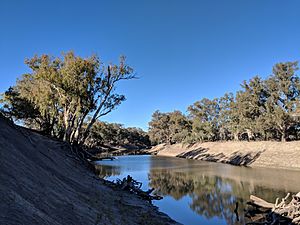Toorale National Park facts for kids
Quick facts for kids Toorale National ParkNew South Wales |
|
|---|---|
|
IUCN Category II (National Park)
|
|
| Nearest town or city | Bourke |
| Established | 26 November 2010 |
| Area | 308.66 km2 (119.2 sq mi) |
| Managing authorities |
|
| Website | Toorale National Park |
| See also | Protected areas of New South Wales |
The Toorale National Park is a special protected area in New South Wales, Australia. It is a national park found in the Far West region of the state. This park covers about 30,866 hectares, which is a very large area.
Toorale National Park is located about 80 kilometres southwest of a town called Bourke. It sits right where two important rivers meet: the Darling River and the Warrego River. The park is also next to Gundabooka National Park and the Toorale State Conservation Area. The park is looked after by the NSW National Parks & Wildlife Service and the local Indigenous Kurnu-Baakandji people.
Contents
Discover Toorale's Unique Landscape
Toorale National Park was once a large farm called Toorale Station. On this farm, people grew crops and raised animals. Today, it is a protected area.
The park has a mostly flat landscape. It has many large floodplains, which are flat areas of land next to a river that often get flooded. There are also some smaller areas with low hills and riverbanks. You can find two notable peaks in the park. Small, temporary lakes called gilgais appear in dips and swamps. Old ways of managing water have created a huge wetland system here.
Plants of Toorale National Park
Toorale National Park has many different types of plants. Scientists have found and mapped 27 different plant groups here. The most common plants are found in the inland floodplain shrublands. These include areas with lignum shrubs and swamps with cane grass. You can also see eurah shrubs and other types of shrubs that grow near rivers.
The banks of the Darling River are lined with tall river red gum trees. Other parts of the Darling and Warrego rivers have coolibah trees. These trees also grow on the floodplains nearby. You can also find black box trees in these areas.
Areas with water for most of the year have shallow sedgelands. These are wetlands with grass-like plants. Bimble box trees grow in sandy areas that sometimes flood. In drier parts of the park, there are many belah, black oak, western rosewood, and leopardwood trees. You can also find areas with whitewood and supplejack trees. Some parts have gidgee and mulga trees. There are also sandy areas with gum coolibah trees.
Animals of Toorale National Park
Toorale National Park is home to many different animals. Scientists have recorded many species in the park and the nearby Toorale State Conservation Area.
Mammals Living in Toorale
At least 28 types of mammals have been seen here. You can find large kangaroos like the red kangaroo, western grey kangaroo, and eastern grey kangaroo. Smaller mammals include the common dunnart and the short-beaked echidna.
Several types of bats live in the park. These include Gould's wattled bat, the lesser long-eared bat, Western broad-nosed bat, little broad-nosed bat, yellow-bellied sheath-tailed bat, and little pied bat.
Some animals that are not native to Australia also live here. These are called introduced pest species. They include the European fox, European rabbit, brown hare, feral cat, feral goat, feral pig, European cow, and House mouse.
Reptiles and Amphibians of Toorale
The park is home to at least 57 types of reptiles. These include the Murray River turtle, Interior blind snake, Leopard Ctenotus, Ringed brown snake, and Sand goanna. You might also spot the Bynoe's gecko and the Central bearded dragon.
There are also 17 types of amphibians, which are animals like frogs. Some of these include the Broad-palmed frog, Desert froglet, and Rough frog.



